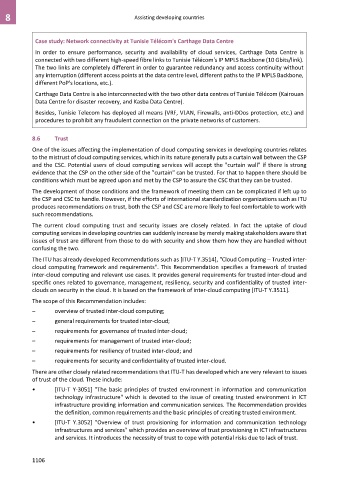Page 1114 - Cloud computing: From paradigm to operation
P. 1114
8 Assisting developing countries
Case study: Network connectivity at Tunisie Télécom's Carthage Data Centre
In order to ensure performance, security and availability of cloud services, Carthage Data Centre is
connected with two different high-speed fibre links to Tunisie Télécom's IP MPLS Backbone (10 Gbits/link).
The two links are completely different in order to guarantee redundancy and access continuity without
any interruption (different access points at the data centre level, different paths to the IP MPLS Backbone,
different PoP's locations, etc.).
Carthage Data Centre is also interconnected with the two other data centres of Tunisie Télécom (Kairouan
Data Centre for disaster recovery, and Kasba Data Centre).
Besides, Tunisie Telecom has deployed all means (VRF, VLAN, Firewalls, anti-DDos protection, etc.) and
procedures to prohibit any fraudulent connection on the private networks of customers.
8.6 Trust
One of the issues affecting the implementation of cloud computing services in developing countries relates
to the mistrust of cloud computing services, which in its nature generally puts a curtain wall between the CSP
and the CSC. Potential users of cloud computing services will accept the "curtain wall" if there is strong
evidence that the CSP on the other side of the "curtain" can be trusted. For that to happen there should be
conditions which must be agreed upon and met by the CSP to assure the CSC that they can be trusted.
The development of those conditions and the framework of meeting them can be complicated if left up to
the CSP and CSC to handle. However, if the efforts of international standardization organizations such as ITU
produces recommendations on trust, both the CSP and CSC are more likely to feel comfortable to work with
such recommendations.
The current cloud computing trust and security issues are closely related. In fact the uptake of cloud
computing services in developing countries can suddenly increase by merely making stakeholders aware that
issues of trust are different from those to do with security and show them how they are handled without
confusing the two.
The ITU has already developed Recommendations such as [ITU-T Y.3514], "Cloud Computing – Trusted inter-
cloud computing framework and requirements". This Recommendation specifies a framework of trusted
inter-cloud computing and relevant use cases. It provides general requirements for trusted inter-cloud and
specific ones related to governance, management, resiliency, security and confidentiality of trusted inter-
clouds on security in the cloud. It is based on the framework of inter-cloud computing [ITU-T Y.3511].
The scope of this Recommendation includes:
– overview of trusted inter-cloud computing;
– general requirements for trusted inter-cloud;
– requirements for governance of trusted inter-cloud;
– requirements for management of trusted inter-cloud;
– requirements for resiliency of trusted inter-cloud; and
– requirements for security and confidentiality of trusted inter-cloud.
There are other closely related recommendations that ITU-T has developed which are very relevant to issues
of trust of the cloud. These include:
• [ITU-T Y-3051] "The basic principles of trusted environment in information and communication
technology infrastructure" which is devoted to the issue of creating trusted environment in ICT
infrastructure providing information and communication services. The Recommendation provides
the definition, common requirements and the basic principles of creating trusted environment.
• [ITU-T Y.3052] "Overview of trust provisioning for information and communication technology
infrastructures and services" which provides an overview of trust provisioning in ICT infrastructures
and services. It introduces the necessity of trust to cope with potential risks due to lack of trust.
1106

